Comprehensive Report: Management and Operations at Unilever
VerifiedAdded on 2020/12/09
|16
|4604
|296
Report
AI Summary
This report provides a comprehensive analysis of Unilever's management and operations. It begins with an introduction to the organization's structure, differentiating between the roles of managers and leaders, and explores their impact on business development, new product development, and team performance. The report delves into various management and leadership theories, including the chaos theory, management by objectives, situational, and systems theories, illustrating their application within Unilever. Key operational functions are identified, along with the roles and responsibilities of managers. The report also assesses the impact of external business environment factors on decision-making, evaluating appropriate management and leadership approaches to meet company objectives. Finally, the report concludes with recommendations for future improvements to be taken by the company, supported by a detailed reference section.
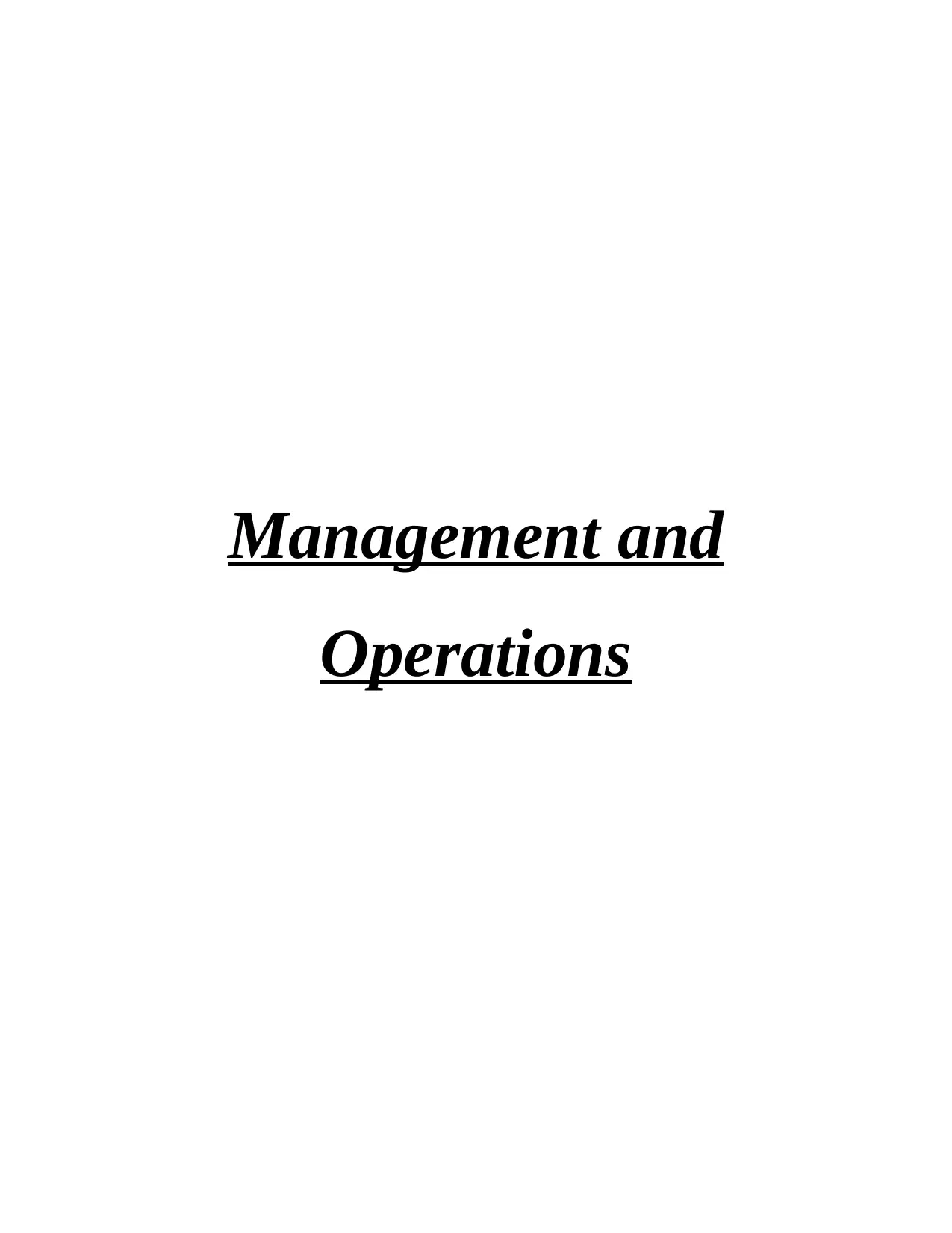
Management and
Operations
Operations
Paraphrase This Document
Need a fresh take? Get an instant paraphrase of this document with our AI Paraphraser
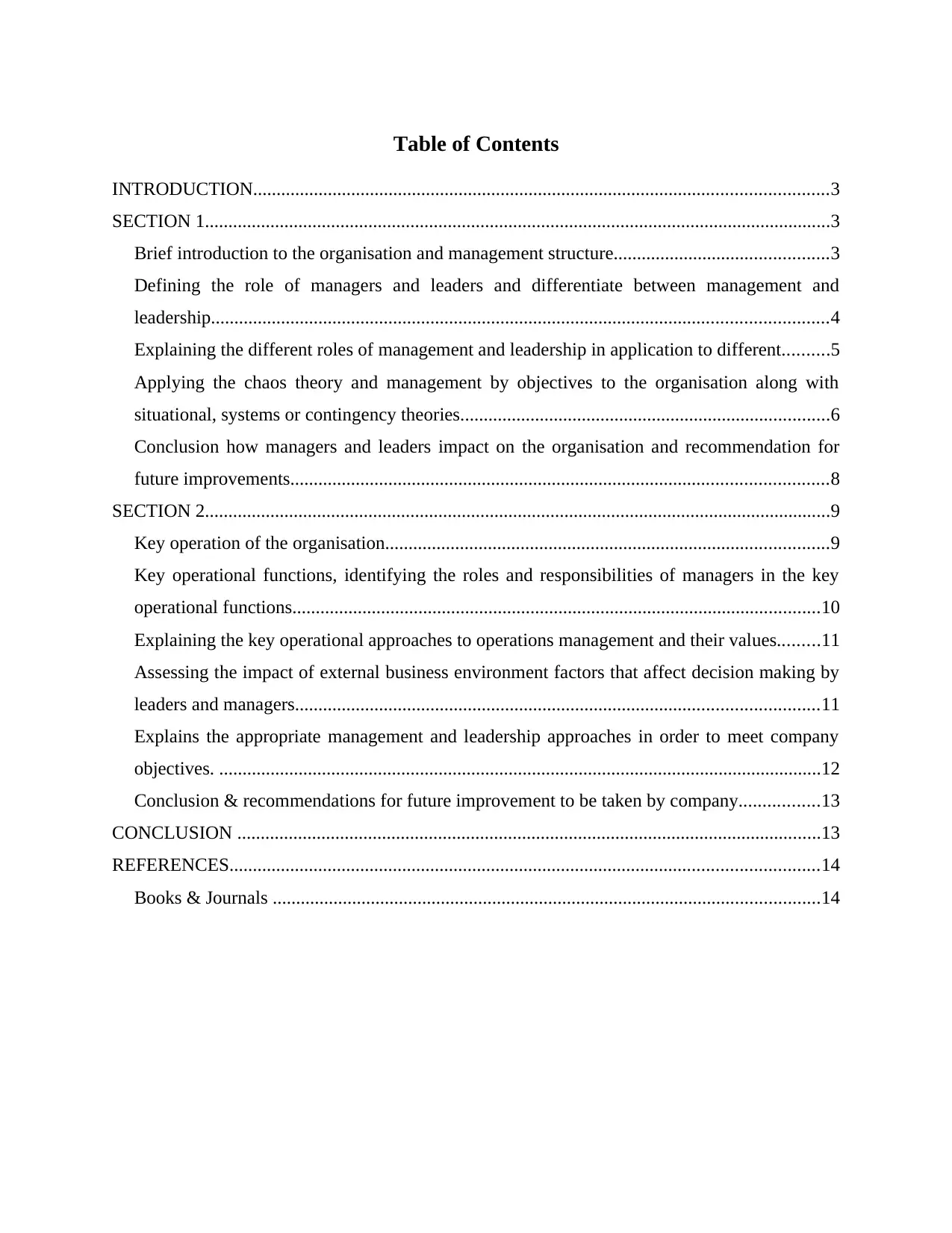
Table of Contents
INTRODUCTION...........................................................................................................................3
SECTION 1......................................................................................................................................3
Brief introduction to the organisation and management structure..............................................3
Defining the role of managers and leaders and differentiate between management and
leadership....................................................................................................................................4
Explaining the different roles of management and leadership in application to different..........5
Applying the chaos theory and management by objectives to the organisation along with
situational, systems or contingency theories...............................................................................6
Conclusion how managers and leaders impact on the organisation and recommendation for
future improvements...................................................................................................................8
SECTION 2......................................................................................................................................9
Key operation of the organisation...............................................................................................9
Key operational functions, identifying the roles and responsibilities of managers in the key
operational functions.................................................................................................................10
Explaining the key operational approaches to operations management and their values.........11
Assessing the impact of external business environment factors that affect decision making by
leaders and managers................................................................................................................11
Explains the appropriate management and leadership approaches in order to meet company
objectives. .................................................................................................................................12
Conclusion & recommendations for future improvement to be taken by company.................13
CONCLUSION .............................................................................................................................13
REFERENCES..............................................................................................................................14
Books & Journals .....................................................................................................................14
INTRODUCTION...........................................................................................................................3
SECTION 1......................................................................................................................................3
Brief introduction to the organisation and management structure..............................................3
Defining the role of managers and leaders and differentiate between management and
leadership....................................................................................................................................4
Explaining the different roles of management and leadership in application to different..........5
Applying the chaos theory and management by objectives to the organisation along with
situational, systems or contingency theories...............................................................................6
Conclusion how managers and leaders impact on the organisation and recommendation for
future improvements...................................................................................................................8
SECTION 2......................................................................................................................................9
Key operation of the organisation...............................................................................................9
Key operational functions, identifying the roles and responsibilities of managers in the key
operational functions.................................................................................................................10
Explaining the key operational approaches to operations management and their values.........11
Assessing the impact of external business environment factors that affect decision making by
leaders and managers................................................................................................................11
Explains the appropriate management and leadership approaches in order to meet company
objectives. .................................................................................................................................12
Conclusion & recommendations for future improvement to be taken by company.................13
CONCLUSION .............................................................................................................................13
REFERENCES..............................................................................................................................14
Books & Journals .....................................................................................................................14
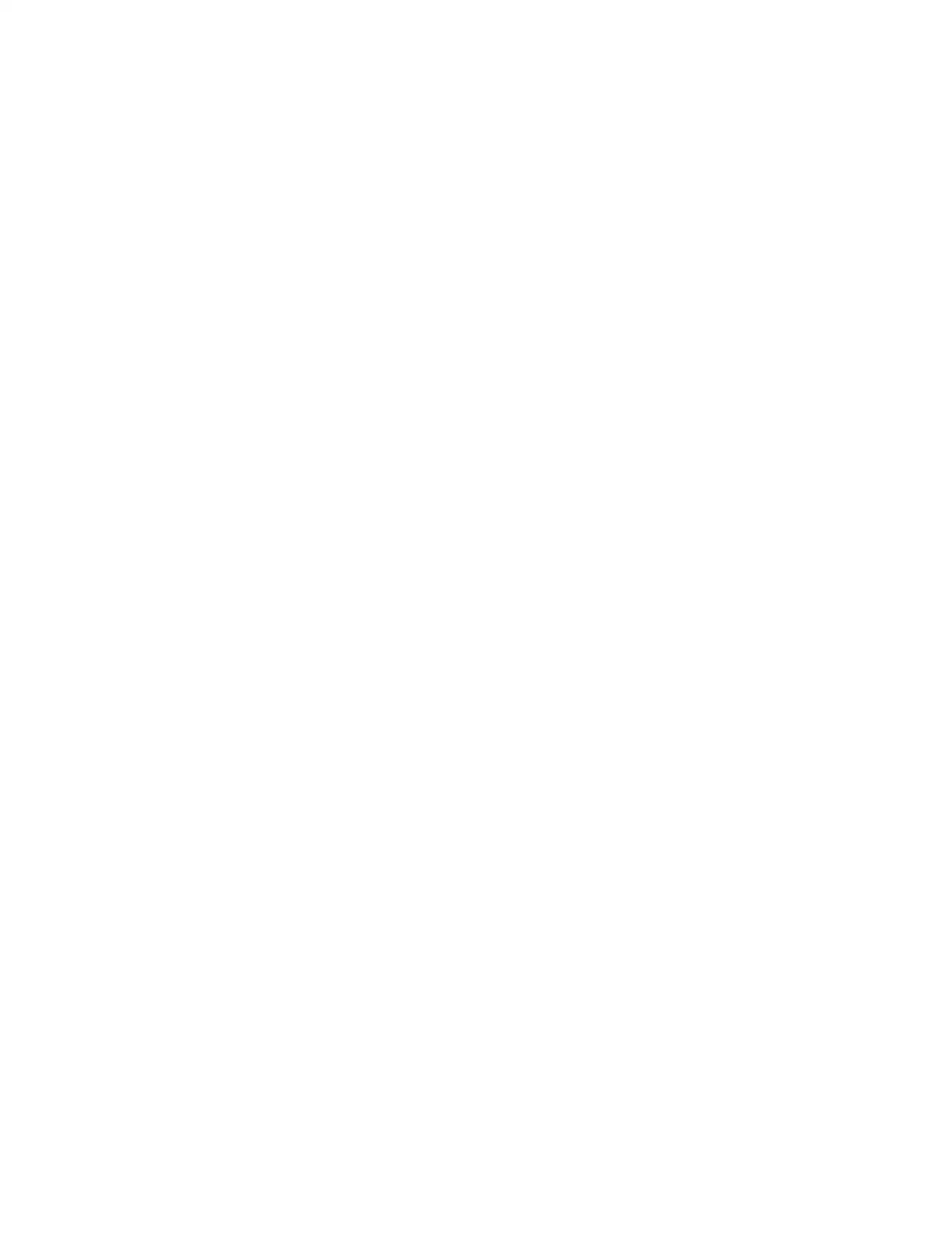
⊘ This is a preview!⊘
Do you want full access?
Subscribe today to unlock all pages.

Trusted by 1+ million students worldwide
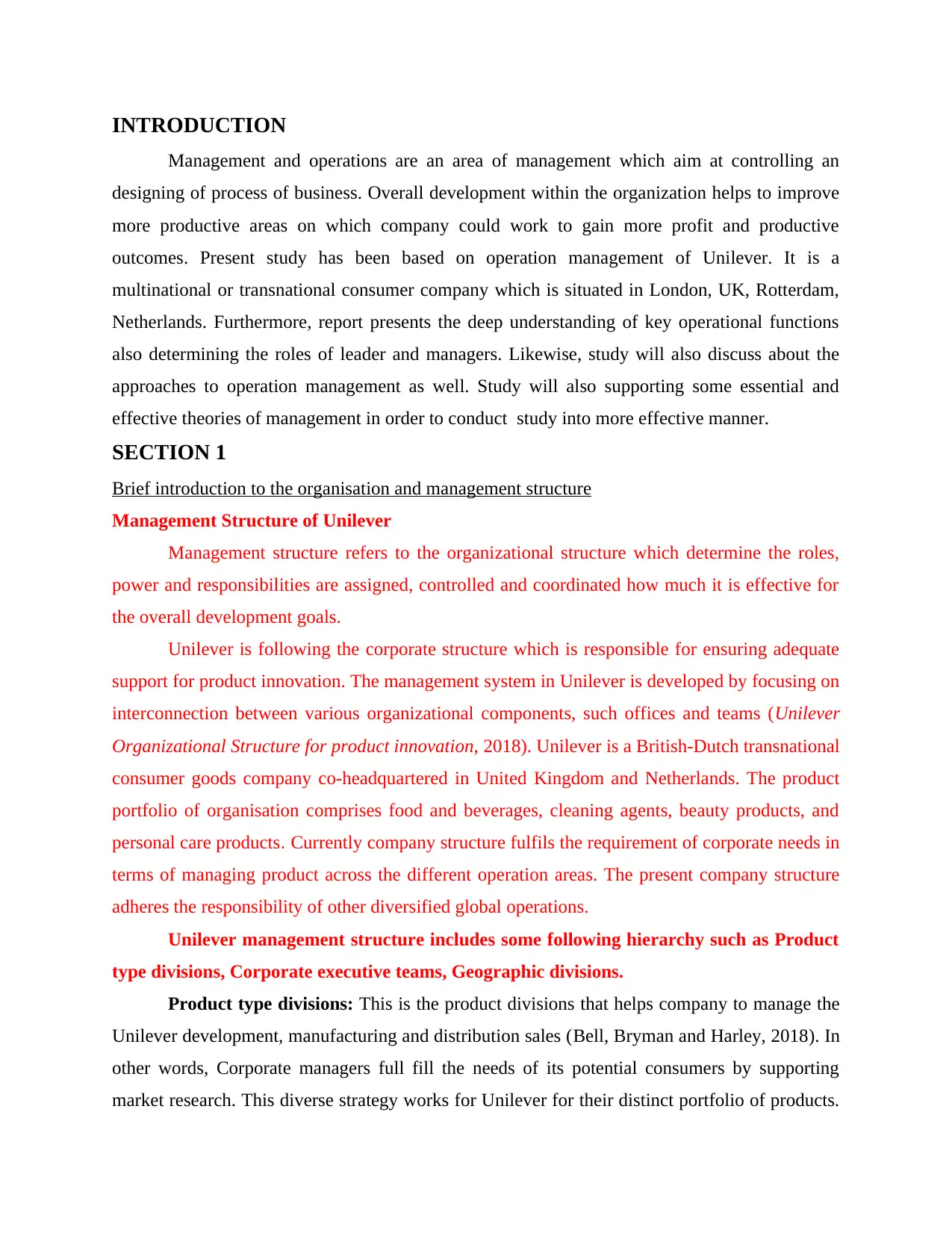
INTRODUCTION
Management and operations are an area of management which aim at controlling an
designing of process of business. Overall development within the organization helps to improve
more productive areas on which company could work to gain more profit and productive
outcomes. Present study has been based on operation management of Unilever. It is a
multinational or transnational consumer company which is situated in London, UK, Rotterdam,
Netherlands. Furthermore, report presents the deep understanding of key operational functions
also determining the roles of leader and managers. Likewise, study will also discuss about the
approaches to operation management as well. Study will also supporting some essential and
effective theories of management in order to conduct study into more effective manner.
SECTION 1
Brief introduction to the organisation and management structure
Management Structure of Unilever
Management structure refers to the organizational structure which determine the roles,
power and responsibilities are assigned, controlled and coordinated how much it is effective for
the overall development goals.
Unilever is following the corporate structure which is responsible for ensuring adequate
support for product innovation. The management system in Unilever is developed by focusing on
interconnection between various organizational components, such offices and teams (Unilever
Organizational Structure for product innovation, 2018). Unilever is a British-Dutch transnational
consumer goods company co-headquartered in United Kingdom and Netherlands. The product
portfolio of organisation comprises food and beverages, cleaning agents, beauty products, and
personal care products. Currently company structure fulfils the requirement of corporate needs in
terms of managing product across the different operation areas. The present company structure
adheres the responsibility of other diversified global operations.
Unilever management structure includes some following hierarchy such as Product
type divisions, Corporate executive teams, Geographic divisions.
Product type divisions: This is the product divisions that helps company to manage the
Unilever development, manufacturing and distribution sales (Bell, Bryman and Harley, 2018). In
other words, Corporate managers full fill the needs of its potential consumers by supporting
market research. This diverse strategy works for Unilever for their distinct portfolio of products.
Management and operations are an area of management which aim at controlling an
designing of process of business. Overall development within the organization helps to improve
more productive areas on which company could work to gain more profit and productive
outcomes. Present study has been based on operation management of Unilever. It is a
multinational or transnational consumer company which is situated in London, UK, Rotterdam,
Netherlands. Furthermore, report presents the deep understanding of key operational functions
also determining the roles of leader and managers. Likewise, study will also discuss about the
approaches to operation management as well. Study will also supporting some essential and
effective theories of management in order to conduct study into more effective manner.
SECTION 1
Brief introduction to the organisation and management structure
Management Structure of Unilever
Management structure refers to the organizational structure which determine the roles,
power and responsibilities are assigned, controlled and coordinated how much it is effective for
the overall development goals.
Unilever is following the corporate structure which is responsible for ensuring adequate
support for product innovation. The management system in Unilever is developed by focusing on
interconnection between various organizational components, such offices and teams (Unilever
Organizational Structure for product innovation, 2018). Unilever is a British-Dutch transnational
consumer goods company co-headquartered in United Kingdom and Netherlands. The product
portfolio of organisation comprises food and beverages, cleaning agents, beauty products, and
personal care products. Currently company structure fulfils the requirement of corporate needs in
terms of managing product across the different operation areas. The present company structure
adheres the responsibility of other diversified global operations.
Unilever management structure includes some following hierarchy such as Product
type divisions, Corporate executive teams, Geographic divisions.
Product type divisions: This is the product divisions that helps company to manage the
Unilever development, manufacturing and distribution sales (Bell, Bryman and Harley, 2018). In
other words, Corporate managers full fill the needs of its potential consumers by supporting
market research. This diverse strategy works for Unilever for their distinct portfolio of products.
Paraphrase This Document
Need a fresh take? Get an instant paraphrase of this document with our AI Paraphraser
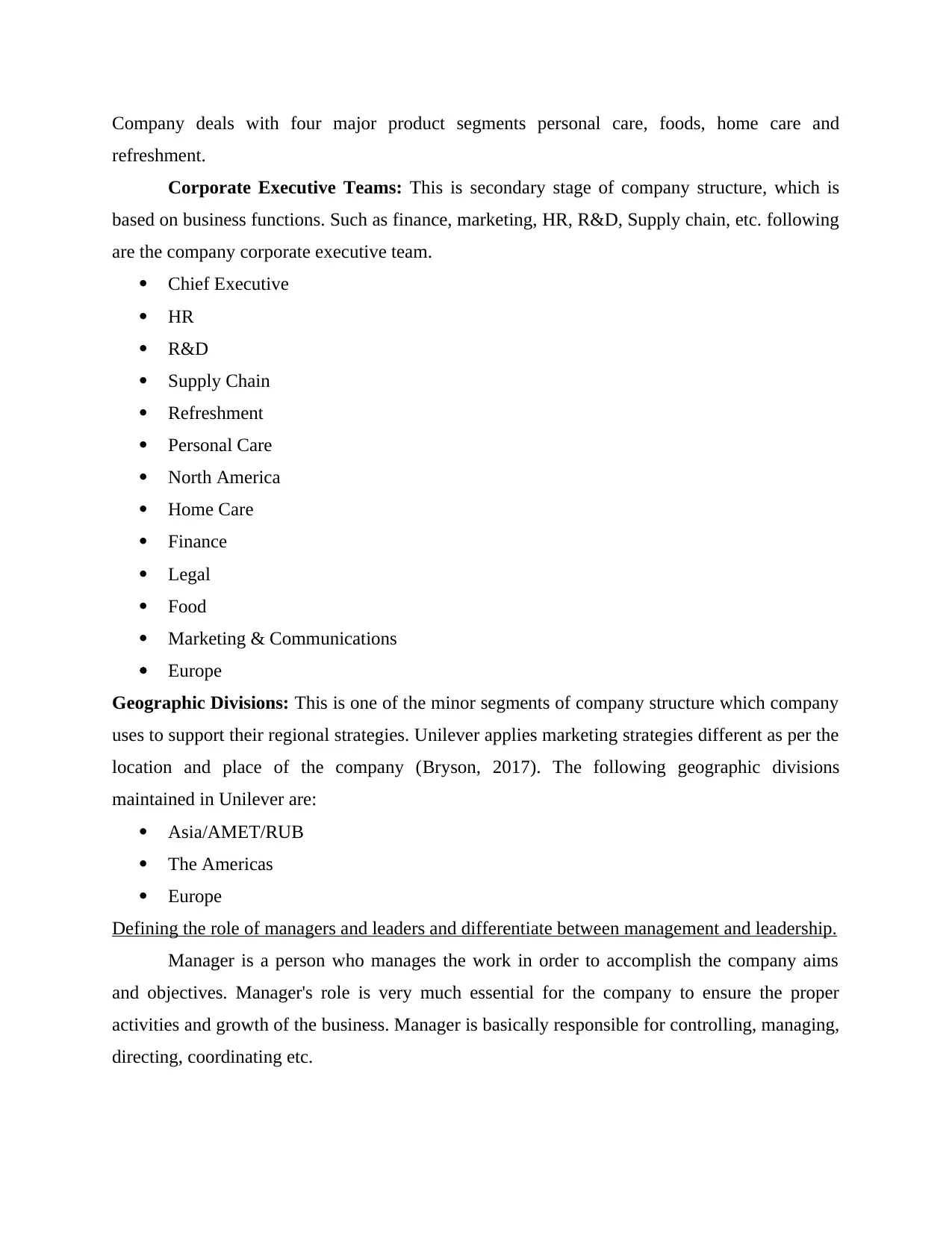
Company deals with four major product segments personal care, foods, home care and
refreshment.
Corporate Executive Teams: This is secondary stage of company structure, which is
based on business functions. Such as finance, marketing, HR, R&D, Supply chain, etc. following
are the company corporate executive team.
Chief Executive
HR
R&D
Supply Chain
Refreshment
Personal Care
North America
Home Care
Finance
Legal
Food
Marketing & Communications
Europe
Geographic Divisions: This is one of the minor segments of company structure which company
uses to support their regional strategies. Unilever applies marketing strategies different as per the
location and place of the company (Bryson, 2017). The following geographic divisions
maintained in Unilever are:
Asia/AMET/RUB
The Americas
Europe
Defining the role of managers and leaders and differentiate between management and leadership.
Manager is a person who manages the work in order to accomplish the company aims
and objectives. Manager's role is very much essential for the company to ensure the proper
activities and growth of the business. Manager is basically responsible for controlling, managing,
directing, coordinating etc.
refreshment.
Corporate Executive Teams: This is secondary stage of company structure, which is
based on business functions. Such as finance, marketing, HR, R&D, Supply chain, etc. following
are the company corporate executive team.
Chief Executive
HR
R&D
Supply Chain
Refreshment
Personal Care
North America
Home Care
Finance
Legal
Food
Marketing & Communications
Europe
Geographic Divisions: This is one of the minor segments of company structure which company
uses to support their regional strategies. Unilever applies marketing strategies different as per the
location and place of the company (Bryson, 2017). The following geographic divisions
maintained in Unilever are:
Asia/AMET/RUB
The Americas
Europe
Defining the role of managers and leaders and differentiate between management and leadership.
Manager is a person who manages the work in order to accomplish the company aims
and objectives. Manager's role is very much essential for the company to ensure the proper
activities and growth of the business. Manager is basically responsible for controlling, managing,
directing, coordinating etc.
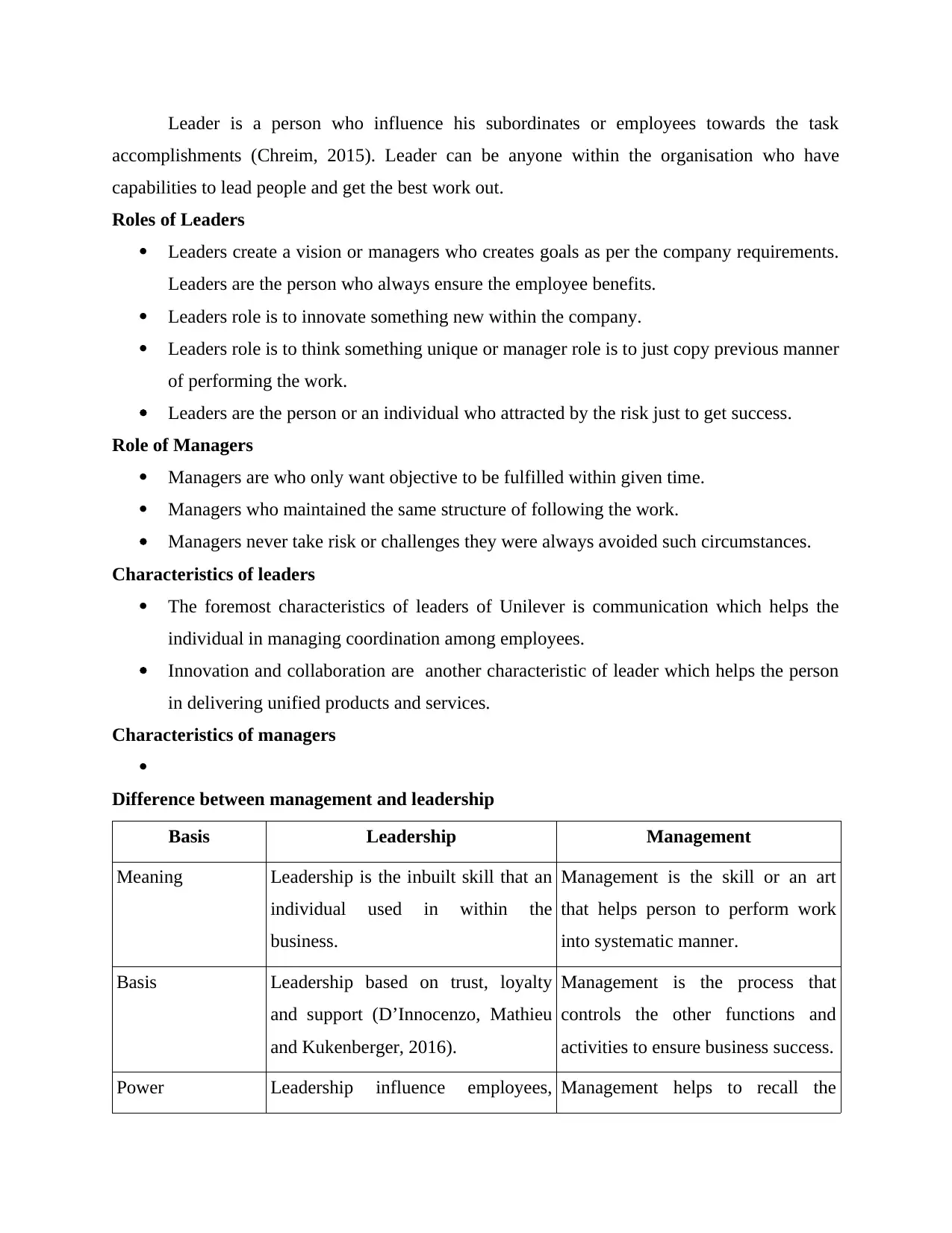
Leader is a person who influence his subordinates or employees towards the task
accomplishments (Chreim, 2015). Leader can be anyone within the organisation who have
capabilities to lead people and get the best work out.
Roles of Leaders
Leaders create a vision or managers who creates goals as per the company requirements.
Leaders are the person who always ensure the employee benefits.
Leaders role is to innovate something new within the company.
Leaders role is to think something unique or manager role is to just copy previous manner
of performing the work.
Leaders are the person or an individual who attracted by the risk just to get success.
Role of Managers
Managers are who only want objective to be fulfilled within given time.
Managers who maintained the same structure of following the work.
Managers never take risk or challenges they were always avoided such circumstances.
Characteristics of leaders
The foremost characteristics of leaders of Unilever is communication which helps the
individual in managing coordination among employees.
Innovation and collaboration are another characteristic of leader which helps the person
in delivering unified products and services.
Characteristics of managers
Difference between management and leadership
Basis Leadership Management
Meaning Leadership is the inbuilt skill that an
individual used in within the
business.
Management is the skill or an art
that helps person to perform work
into systematic manner.
Basis Leadership based on trust, loyalty
and support (D’Innocenzo, Mathieu
and Kukenberger, 2016).
Management is the process that
controls the other functions and
activities to ensure business success.
Power Leadership influence employees, Management helps to recall the
accomplishments (Chreim, 2015). Leader can be anyone within the organisation who have
capabilities to lead people and get the best work out.
Roles of Leaders
Leaders create a vision or managers who creates goals as per the company requirements.
Leaders are the person who always ensure the employee benefits.
Leaders role is to innovate something new within the company.
Leaders role is to think something unique or manager role is to just copy previous manner
of performing the work.
Leaders are the person or an individual who attracted by the risk just to get success.
Role of Managers
Managers are who only want objective to be fulfilled within given time.
Managers who maintained the same structure of following the work.
Managers never take risk or challenges they were always avoided such circumstances.
Characteristics of leaders
The foremost characteristics of leaders of Unilever is communication which helps the
individual in managing coordination among employees.
Innovation and collaboration are another characteristic of leader which helps the person
in delivering unified products and services.
Characteristics of managers
Difference between management and leadership
Basis Leadership Management
Meaning Leadership is the inbuilt skill that an
individual used in within the
business.
Management is the skill or an art
that helps person to perform work
into systematic manner.
Basis Leadership based on trust, loyalty
and support (D’Innocenzo, Mathieu
and Kukenberger, 2016).
Management is the process that
controls the other functions and
activities to ensure business success.
Power Leadership influence employees, Management helps to recall the
⊘ This is a preview!⊘
Do you want full access?
Subscribe today to unlock all pages.

Trusted by 1+ million students worldwide
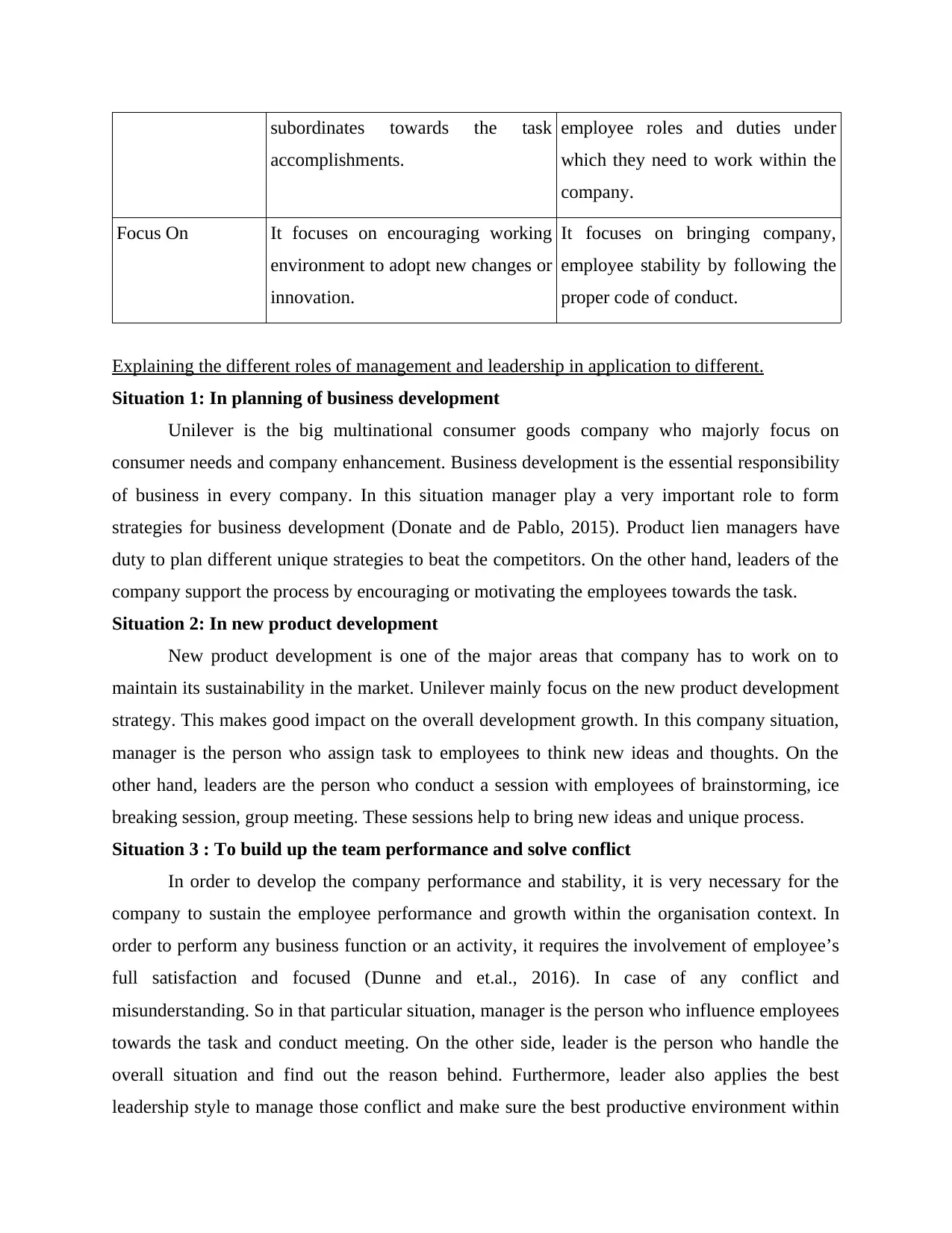
subordinates towards the task
accomplishments.
employee roles and duties under
which they need to work within the
company.
Focus On It focuses on encouraging working
environment to adopt new changes or
innovation.
It focuses on bringing company,
employee stability by following the
proper code of conduct.
Explaining the different roles of management and leadership in application to different.
Situation 1: In planning of business development
Unilever is the big multinational consumer goods company who majorly focus on
consumer needs and company enhancement. Business development is the essential responsibility
of business in every company. In this situation manager play a very important role to form
strategies for business development (Donate and de Pablo, 2015). Product lien managers have
duty to plan different unique strategies to beat the competitors. On the other hand, leaders of the
company support the process by encouraging or motivating the employees towards the task.
Situation 2: In new product development
New product development is one of the major areas that company has to work on to
maintain its sustainability in the market. Unilever mainly focus on the new product development
strategy. This makes good impact on the overall development growth. In this company situation,
manager is the person who assign task to employees to think new ideas and thoughts. On the
other hand, leaders are the person who conduct a session with employees of brainstorming, ice
breaking session, group meeting. These sessions help to bring new ideas and unique process.
Situation 3 : To build up the team performance and solve conflict
In order to develop the company performance and stability, it is very necessary for the
company to sustain the employee performance and growth within the organisation context. In
order to perform any business function or an activity, it requires the involvement of employee’s
full satisfaction and focused (Dunne and et.al., 2016). In case of any conflict and
misunderstanding. So in that particular situation, manager is the person who influence employees
towards the task and conduct meeting. On the other side, leader is the person who handle the
overall situation and find out the reason behind. Furthermore, leader also applies the best
leadership style to manage those conflict and make sure the best productive environment within
accomplishments.
employee roles and duties under
which they need to work within the
company.
Focus On It focuses on encouraging working
environment to adopt new changes or
innovation.
It focuses on bringing company,
employee stability by following the
proper code of conduct.
Explaining the different roles of management and leadership in application to different.
Situation 1: In planning of business development
Unilever is the big multinational consumer goods company who majorly focus on
consumer needs and company enhancement. Business development is the essential responsibility
of business in every company. In this situation manager play a very important role to form
strategies for business development (Donate and de Pablo, 2015). Product lien managers have
duty to plan different unique strategies to beat the competitors. On the other hand, leaders of the
company support the process by encouraging or motivating the employees towards the task.
Situation 2: In new product development
New product development is one of the major areas that company has to work on to
maintain its sustainability in the market. Unilever mainly focus on the new product development
strategy. This makes good impact on the overall development growth. In this company situation,
manager is the person who assign task to employees to think new ideas and thoughts. On the
other hand, leaders are the person who conduct a session with employees of brainstorming, ice
breaking session, group meeting. These sessions help to bring new ideas and unique process.
Situation 3 : To build up the team performance and solve conflict
In order to develop the company performance and stability, it is very necessary for the
company to sustain the employee performance and growth within the organisation context. In
order to perform any business function or an activity, it requires the involvement of employee’s
full satisfaction and focused (Dunne and et.al., 2016). In case of any conflict and
misunderstanding. So in that particular situation, manager is the person who influence employees
towards the task and conduct meeting. On the other side, leader is the person who handle the
overall situation and find out the reason behind. Furthermore, leader also applies the best
leadership style to manage those conflict and make sure the best productive environment within
Paraphrase This Document
Need a fresh take? Get an instant paraphrase of this document with our AI Paraphraser
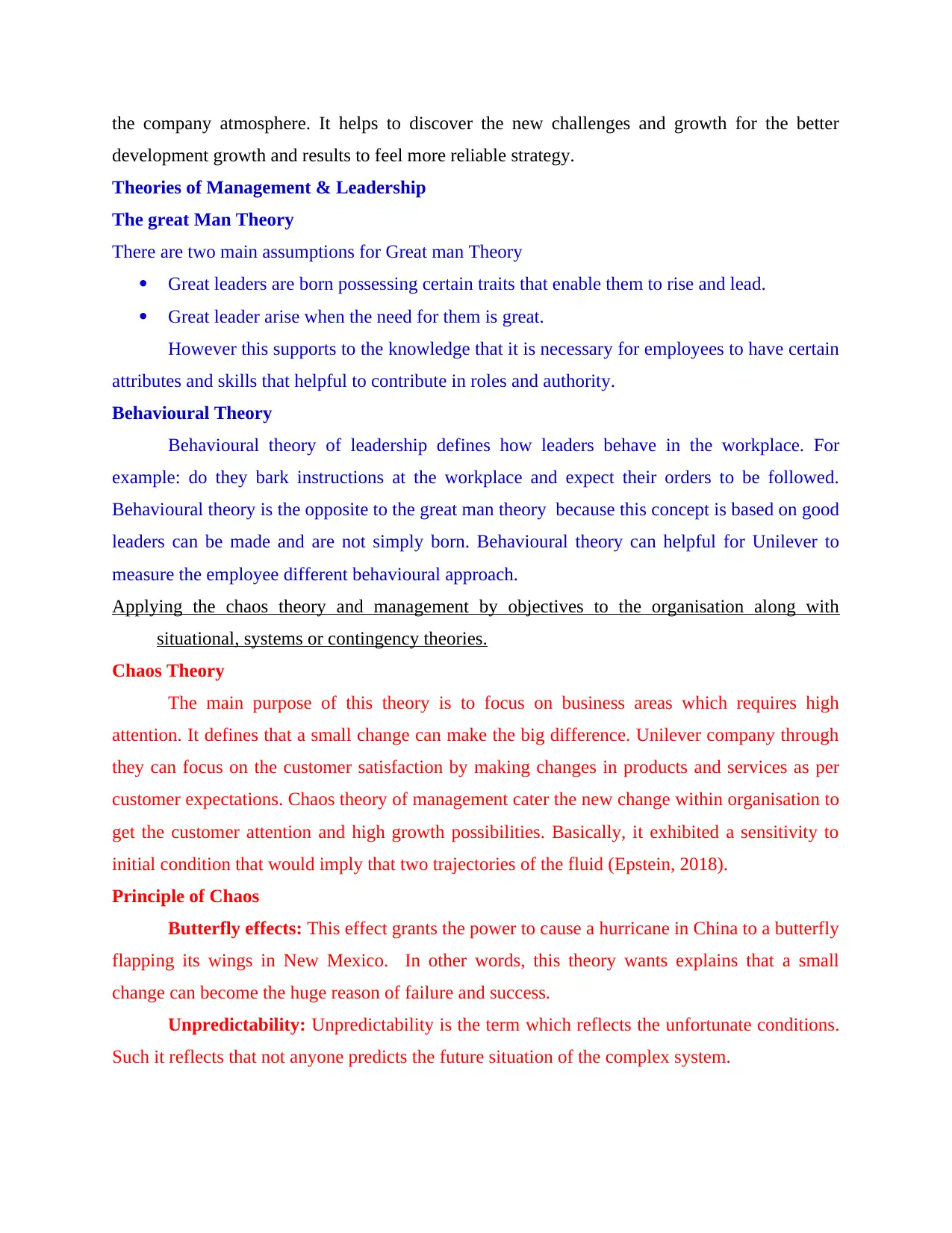
the company atmosphere. It helps to discover the new challenges and growth for the better
development growth and results to feel more reliable strategy.
Theories of Management & Leadership
The great Man Theory
There are two main assumptions for Great man Theory
Great leaders are born possessing certain traits that enable them to rise and lead.
Great leader arise when the need for them is great.
However this supports to the knowledge that it is necessary for employees to have certain
attributes and skills that helpful to contribute in roles and authority.
Behavioural Theory
Behavioural theory of leadership defines how leaders behave in the workplace. For
example: do they bark instructions at the workplace and expect their orders to be followed.
Behavioural theory is the opposite to the great man theory because this concept is based on good
leaders can be made and are not simply born. Behavioural theory can helpful for Unilever to
measure the employee different behavioural approach.
Applying the chaos theory and management by objectives to the organisation along with
situational, systems or contingency theories.
Chaos Theory
The main purpose of this theory is to focus on business areas which requires high
attention. It defines that a small change can make the big difference. Unilever company through
they can focus on the customer satisfaction by making changes in products and services as per
customer expectations. Chaos theory of management cater the new change within organisation to
get the customer attention and high growth possibilities. Basically, it exhibited a sensitivity to
initial condition that would imply that two trajectories of the fluid (Epstein, 2018).
Principle of Chaos
Butterfly effects: This effect grants the power to cause a hurricane in China to a butterfly
flapping its wings in New Mexico. In other words, this theory wants explains that a small
change can become the huge reason of failure and success.
Unpredictability: Unpredictability is the term which reflects the unfortunate conditions.
Such it reflects that not anyone predicts the future situation of the complex system.
development growth and results to feel more reliable strategy.
Theories of Management & Leadership
The great Man Theory
There are two main assumptions for Great man Theory
Great leaders are born possessing certain traits that enable them to rise and lead.
Great leader arise when the need for them is great.
However this supports to the knowledge that it is necessary for employees to have certain
attributes and skills that helpful to contribute in roles and authority.
Behavioural Theory
Behavioural theory of leadership defines how leaders behave in the workplace. For
example: do they bark instructions at the workplace and expect their orders to be followed.
Behavioural theory is the opposite to the great man theory because this concept is based on good
leaders can be made and are not simply born. Behavioural theory can helpful for Unilever to
measure the employee different behavioural approach.
Applying the chaos theory and management by objectives to the organisation along with
situational, systems or contingency theories.
Chaos Theory
The main purpose of this theory is to focus on business areas which requires high
attention. It defines that a small change can make the big difference. Unilever company through
they can focus on the customer satisfaction by making changes in products and services as per
customer expectations. Chaos theory of management cater the new change within organisation to
get the customer attention and high growth possibilities. Basically, it exhibited a sensitivity to
initial condition that would imply that two trajectories of the fluid (Epstein, 2018).
Principle of Chaos
Butterfly effects: This effect grants the power to cause a hurricane in China to a butterfly
flapping its wings in New Mexico. In other words, this theory wants explains that a small
change can become the huge reason of failure and success.
Unpredictability: Unpredictability is the term which reflects the unfortunate conditions.
Such it reflects that not anyone predicts the future situation of the complex system.
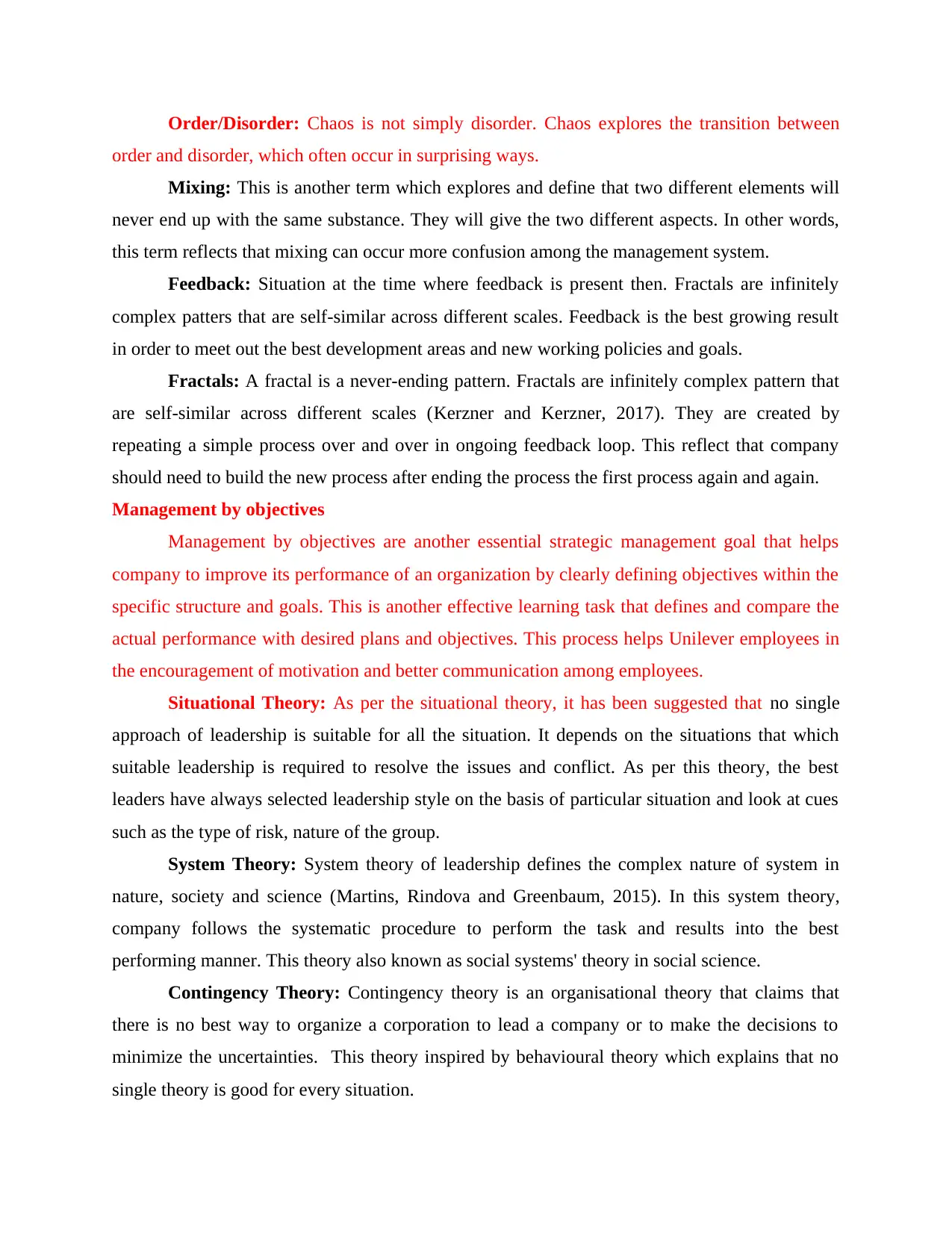
Order/Disorder: Chaos is not simply disorder. Chaos explores the transition between
order and disorder, which often occur in surprising ways.
Mixing: This is another term which explores and define that two different elements will
never end up with the same substance. They will give the two different aspects. In other words,
this term reflects that mixing can occur more confusion among the management system.
Feedback: Situation at the time where feedback is present then. Fractals are infinitely
complex patters that are self-similar across different scales. Feedback is the best growing result
in order to meet out the best development areas and new working policies and goals.
Fractals: A fractal is a never-ending pattern. Fractals are infinitely complex pattern that
are self-similar across different scales (Kerzner and Kerzner, 2017). They are created by
repeating a simple process over and over in ongoing feedback loop. This reflect that company
should need to build the new process after ending the process the first process again and again.
Management by objectives
Management by objectives are another essential strategic management goal that helps
company to improve its performance of an organization by clearly defining objectives within the
specific structure and goals. This is another effective learning task that defines and compare the
actual performance with desired plans and objectives. This process helps Unilever employees in
the encouragement of motivation and better communication among employees.
Situational Theory: As per the situational theory, it has been suggested that no single
approach of leadership is suitable for all the situation. It depends on the situations that which
suitable leadership is required to resolve the issues and conflict. As per this theory, the best
leaders have always selected leadership style on the basis of particular situation and look at cues
such as the type of risk, nature of the group.
System Theory: System theory of leadership defines the complex nature of system in
nature, society and science (Martins, Rindova and Greenbaum, 2015). In this system theory,
company follows the systematic procedure to perform the task and results into the best
performing manner. This theory also known as social systems' theory in social science.
Contingency Theory: Contingency theory is an organisational theory that claims that
there is no best way to organize a corporation to lead a company or to make the decisions to
minimize the uncertainties. This theory inspired by behavioural theory which explains that no
single theory is good for every situation.
order and disorder, which often occur in surprising ways.
Mixing: This is another term which explores and define that two different elements will
never end up with the same substance. They will give the two different aspects. In other words,
this term reflects that mixing can occur more confusion among the management system.
Feedback: Situation at the time where feedback is present then. Fractals are infinitely
complex patters that are self-similar across different scales. Feedback is the best growing result
in order to meet out the best development areas and new working policies and goals.
Fractals: A fractal is a never-ending pattern. Fractals are infinitely complex pattern that
are self-similar across different scales (Kerzner and Kerzner, 2017). They are created by
repeating a simple process over and over in ongoing feedback loop. This reflect that company
should need to build the new process after ending the process the first process again and again.
Management by objectives
Management by objectives are another essential strategic management goal that helps
company to improve its performance of an organization by clearly defining objectives within the
specific structure and goals. This is another effective learning task that defines and compare the
actual performance with desired plans and objectives. This process helps Unilever employees in
the encouragement of motivation and better communication among employees.
Situational Theory: As per the situational theory, it has been suggested that no single
approach of leadership is suitable for all the situation. It depends on the situations that which
suitable leadership is required to resolve the issues and conflict. As per this theory, the best
leaders have always selected leadership style on the basis of particular situation and look at cues
such as the type of risk, nature of the group.
System Theory: System theory of leadership defines the complex nature of system in
nature, society and science (Martins, Rindova and Greenbaum, 2015). In this system theory,
company follows the systematic procedure to perform the task and results into the best
performing manner. This theory also known as social systems' theory in social science.
Contingency Theory: Contingency theory is an organisational theory that claims that
there is no best way to organize a corporation to lead a company or to make the decisions to
minimize the uncertainties. This theory inspired by behavioural theory which explains that no
single theory is good for every situation.
⊘ This is a preview!⊘
Do you want full access?
Subscribe today to unlock all pages.

Trusted by 1+ million students worldwide
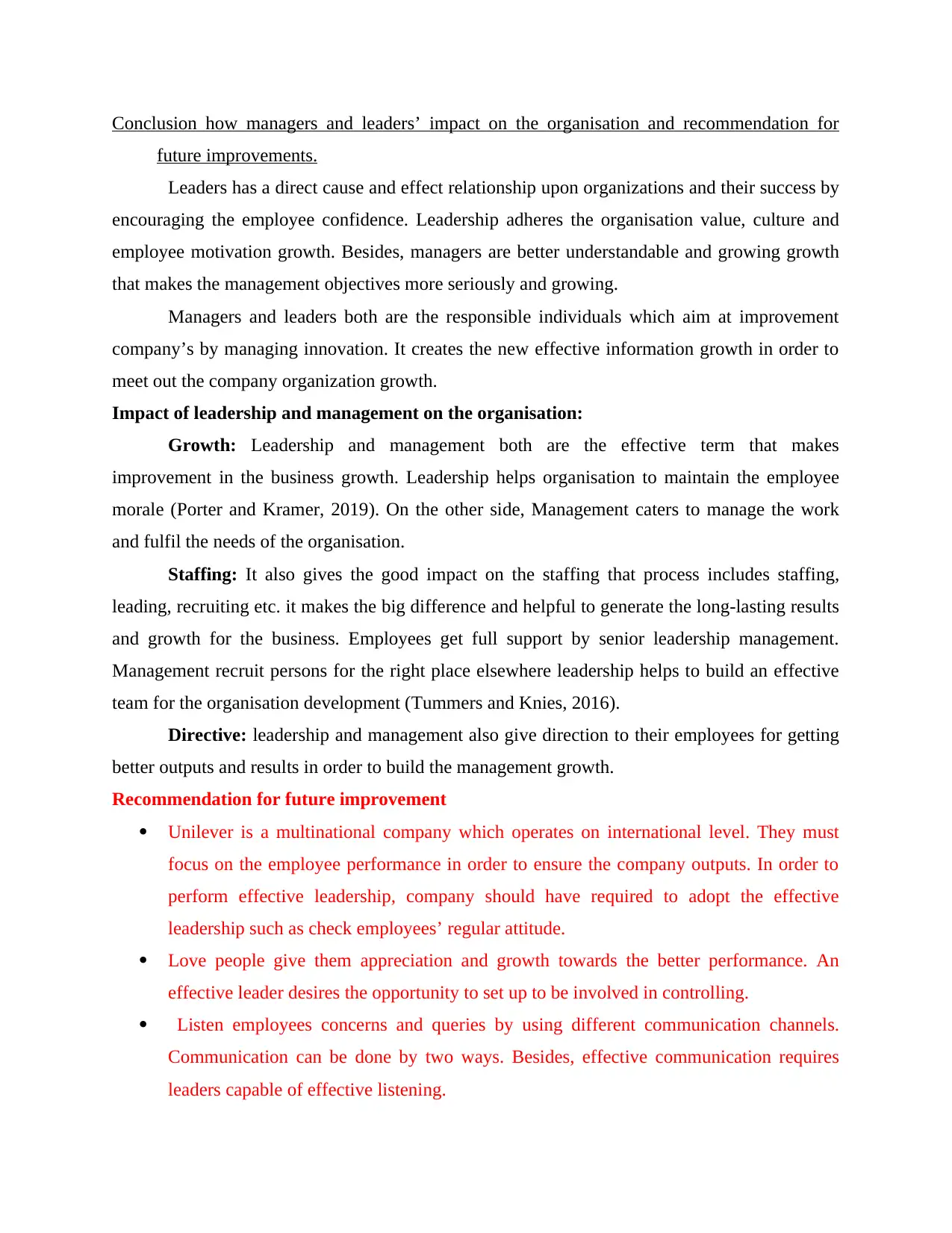
Conclusion how managers and leaders’ impact on the organisation and recommendation for
future improvements.
Leaders has a direct cause and effect relationship upon organizations and their success by
encouraging the employee confidence. Leadership adheres the organisation value, culture and
employee motivation growth. Besides, managers are better understandable and growing growth
that makes the management objectives more seriously and growing.
Managers and leaders both are the responsible individuals which aim at improvement
company’s by managing innovation. It creates the new effective information growth in order to
meet out the company organization growth.
Impact of leadership and management on the organisation:
Growth: Leadership and management both are the effective term that makes
improvement in the business growth. Leadership helps organisation to maintain the employee
morale (Porter and Kramer, 2019). On the other side, Management caters to manage the work
and fulfil the needs of the organisation.
Staffing: It also gives the good impact on the staffing that process includes staffing,
leading, recruiting etc. it makes the big difference and helpful to generate the long-lasting results
and growth for the business. Employees get full support by senior leadership management.
Management recruit persons for the right place elsewhere leadership helps to build an effective
team for the organisation development (Tummers and Knies, 2016).
Directive: leadership and management also give direction to their employees for getting
better outputs and results in order to build the management growth.
Recommendation for future improvement
Unilever is a multinational company which operates on international level. They must
focus on the employee performance in order to ensure the company outputs. In order to
perform effective leadership, company should have required to adopt the effective
leadership such as check employees’ regular attitude.
Love people give them appreciation and growth towards the better performance. An
effective leader desires the opportunity to set up to be involved in controlling.
Listen employees concerns and queries by using different communication channels.
Communication can be done by two ways. Besides, effective communication requires
leaders capable of effective listening.
future improvements.
Leaders has a direct cause and effect relationship upon organizations and their success by
encouraging the employee confidence. Leadership adheres the organisation value, culture and
employee motivation growth. Besides, managers are better understandable and growing growth
that makes the management objectives more seriously and growing.
Managers and leaders both are the responsible individuals which aim at improvement
company’s by managing innovation. It creates the new effective information growth in order to
meet out the company organization growth.
Impact of leadership and management on the organisation:
Growth: Leadership and management both are the effective term that makes
improvement in the business growth. Leadership helps organisation to maintain the employee
morale (Porter and Kramer, 2019). On the other side, Management caters to manage the work
and fulfil the needs of the organisation.
Staffing: It also gives the good impact on the staffing that process includes staffing,
leading, recruiting etc. it makes the big difference and helpful to generate the long-lasting results
and growth for the business. Employees get full support by senior leadership management.
Management recruit persons for the right place elsewhere leadership helps to build an effective
team for the organisation development (Tummers and Knies, 2016).
Directive: leadership and management also give direction to their employees for getting
better outputs and results in order to build the management growth.
Recommendation for future improvement
Unilever is a multinational company which operates on international level. They must
focus on the employee performance in order to ensure the company outputs. In order to
perform effective leadership, company should have required to adopt the effective
leadership such as check employees’ regular attitude.
Love people give them appreciation and growth towards the better performance. An
effective leader desires the opportunity to set up to be involved in controlling.
Listen employees concerns and queries by using different communication channels.
Communication can be done by two ways. Besides, effective communication requires
leaders capable of effective listening.
Paraphrase This Document
Need a fresh take? Get an instant paraphrase of this document with our AI Paraphraser
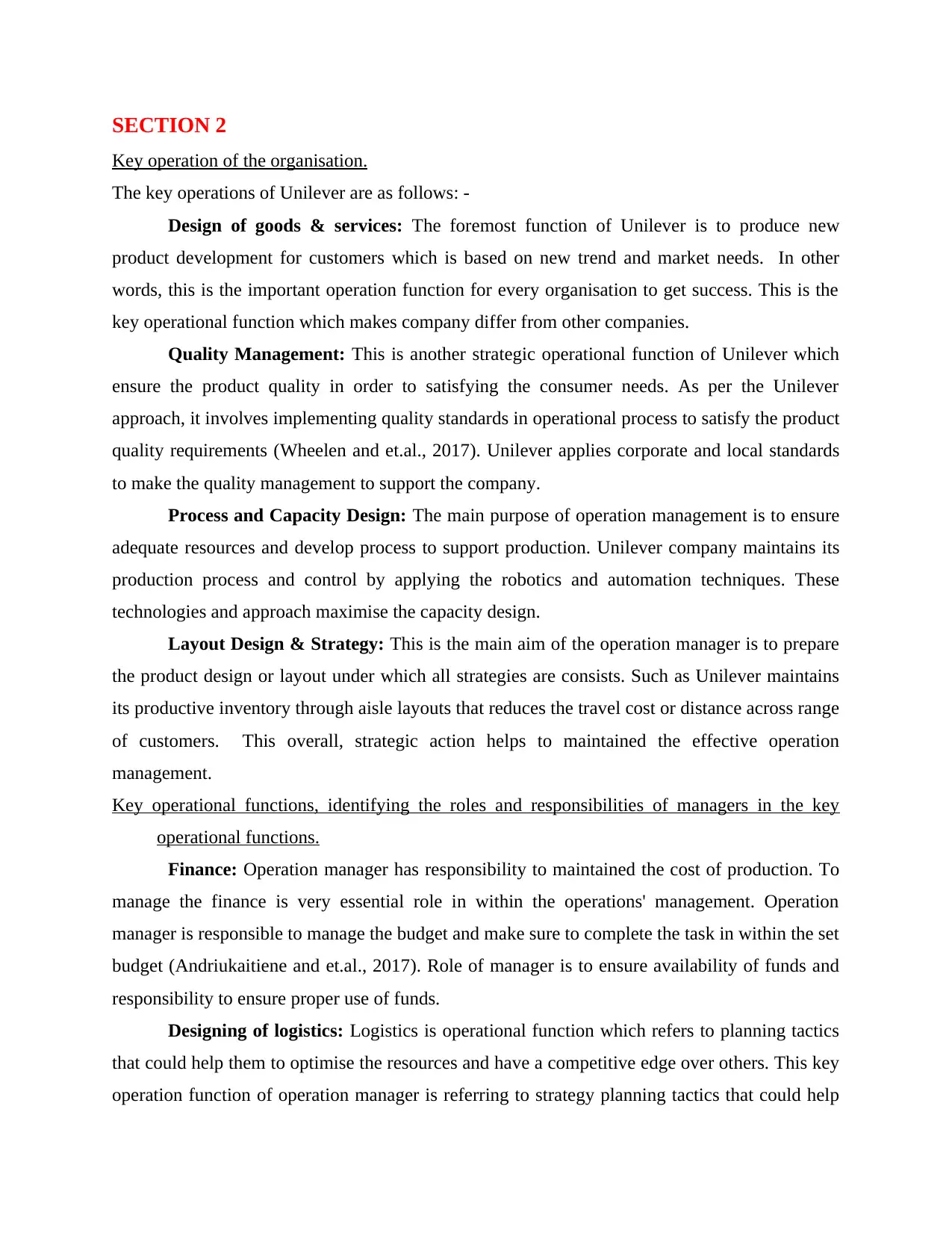
SECTION 2
Key operation of the organisation.
The key operations of Unilever are as follows: -
Design of goods & services: The foremost function of Unilever is to produce new
product development for customers which is based on new trend and market needs. In other
words, this is the important operation function for every organisation to get success. This is the
key operational function which makes company differ from other companies.
Quality Management: This is another strategic operational function of Unilever which
ensure the product quality in order to satisfying the consumer needs. As per the Unilever
approach, it involves implementing quality standards in operational process to satisfy the product
quality requirements (Wheelen and et.al., 2017). Unilever applies corporate and local standards
to make the quality management to support the company.
Process and Capacity Design: The main purpose of operation management is to ensure
adequate resources and develop process to support production. Unilever company maintains its
production process and control by applying the robotics and automation techniques. These
technologies and approach maximise the capacity design.
Layout Design & Strategy: This is the main aim of the operation manager is to prepare
the product design or layout under which all strategies are consists. Such as Unilever maintains
its productive inventory through aisle layouts that reduces the travel cost or distance across range
of customers. This overall, strategic action helps to maintained the effective operation
management.
Key operational functions, identifying the roles and responsibilities of managers in the key
operational functions.
Finance: Operation manager has responsibility to maintained the cost of production. To
manage the finance is very essential role in within the operations' management. Operation
manager is responsible to manage the budget and make sure to complete the task in within the set
budget (Аndriukaitiene and et.al., 2017). Role of manager is to ensure availability of funds and
responsibility to ensure proper use of funds.
Designing of logistics: Logistics is operational function which refers to planning tactics
that could help them to optimise the resources and have a competitive edge over others. This key
operation function of operation manager is referring to strategy planning tactics that could help
Key operation of the organisation.
The key operations of Unilever are as follows: -
Design of goods & services: The foremost function of Unilever is to produce new
product development for customers which is based on new trend and market needs. In other
words, this is the important operation function for every organisation to get success. This is the
key operational function which makes company differ from other companies.
Quality Management: This is another strategic operational function of Unilever which
ensure the product quality in order to satisfying the consumer needs. As per the Unilever
approach, it involves implementing quality standards in operational process to satisfy the product
quality requirements (Wheelen and et.al., 2017). Unilever applies corporate and local standards
to make the quality management to support the company.
Process and Capacity Design: The main purpose of operation management is to ensure
adequate resources and develop process to support production. Unilever company maintains its
production process and control by applying the robotics and automation techniques. These
technologies and approach maximise the capacity design.
Layout Design & Strategy: This is the main aim of the operation manager is to prepare
the product design or layout under which all strategies are consists. Such as Unilever maintains
its productive inventory through aisle layouts that reduces the travel cost or distance across range
of customers. This overall, strategic action helps to maintained the effective operation
management.
Key operational functions, identifying the roles and responsibilities of managers in the key
operational functions.
Finance: Operation manager has responsibility to maintained the cost of production. To
manage the finance is very essential role in within the operations' management. Operation
manager is responsible to manage the budget and make sure to complete the task in within the set
budget (Аndriukaitiene and et.al., 2017). Role of manager is to ensure availability of funds and
responsibility to ensure proper use of funds.
Designing of logistics: Logistics is operational function which refers to planning tactics
that could help them to optimise the resources and have a competitive edge over others. This key
operation function of operation manager is referring to strategy planning tactics that could help
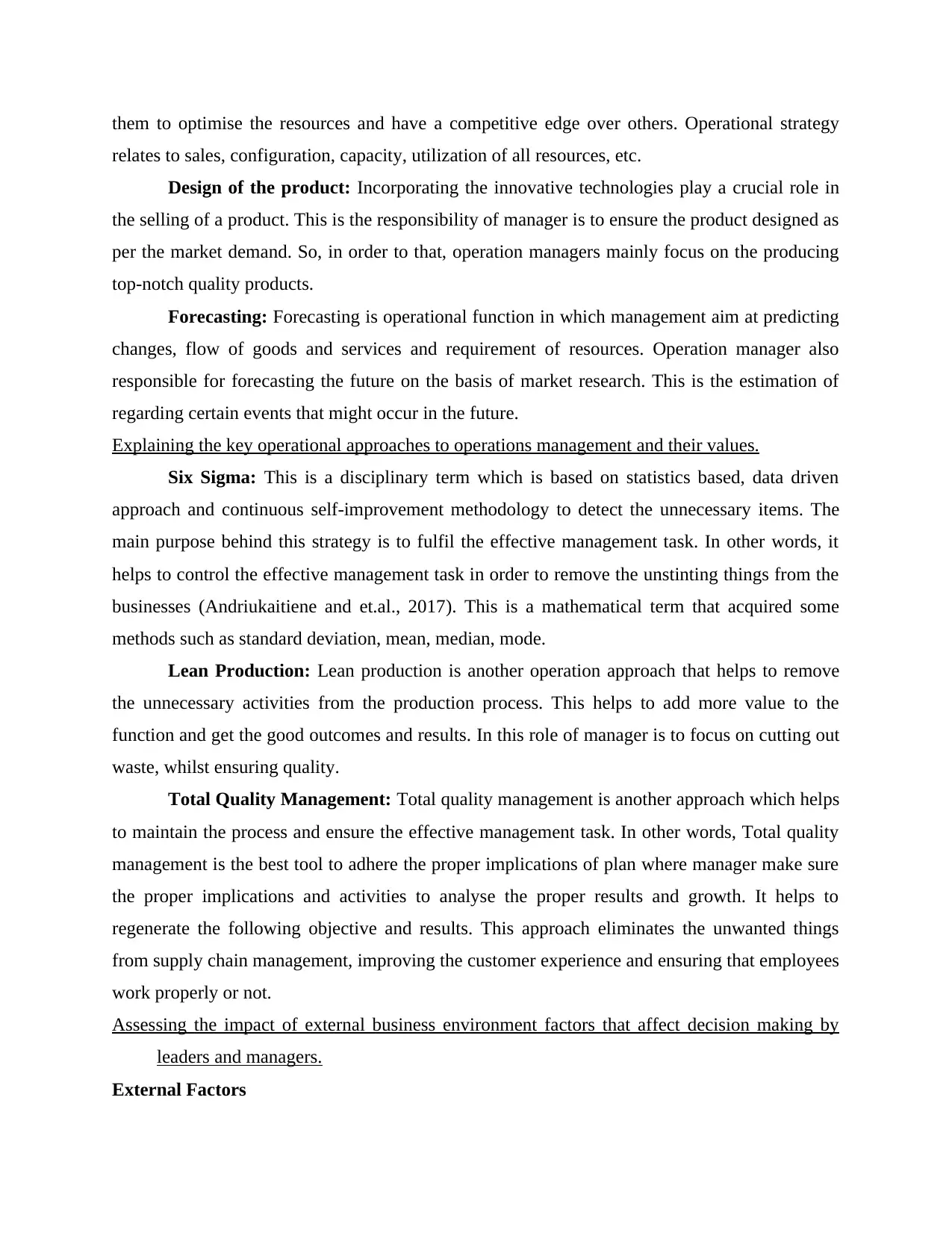
them to optimise the resources and have a competitive edge over others. Operational strategy
relates to sales, configuration, capacity, utilization of all resources, etc.
Design of the product: Incorporating the innovative technologies play a crucial role in
the selling of a product. This is the responsibility of manager is to ensure the product designed as
per the market demand. So, in order to that, operation managers mainly focus on the producing
top-notch quality products.
Forecasting: Forecasting is operational function in which management aim at predicting
changes, flow of goods and services and requirement of resources. Operation manager also
responsible for forecasting the future on the basis of market research. This is the estimation of
regarding certain events that might occur in the future.
Explaining the key operational approaches to operations management and their values.
Six Sigma: This is a disciplinary term which is based on statistics based, data driven
approach and continuous self-improvement methodology to detect the unnecessary items. The
main purpose behind this strategy is to fulfil the effective management task. In other words, it
helps to control the effective management task in order to remove the unstinting things from the
businesses (Аndriukaitiene and et.al., 2017). This is a mathematical term that acquired some
methods such as standard deviation, mean, median, mode.
Lean Production: Lean production is another operation approach that helps to remove
the unnecessary activities from the production process. This helps to add more value to the
function and get the good outcomes and results. In this role of manager is to focus on cutting out
waste, whilst ensuring quality.
Total Quality Management: Total quality management is another approach which helps
to maintain the process and ensure the effective management task. In other words, Total quality
management is the best tool to adhere the proper implications of plan where manager make sure
the proper implications and activities to analyse the proper results and growth. It helps to
regenerate the following objective and results. This approach eliminates the unwanted things
from supply chain management, improving the customer experience and ensuring that employees
work properly or not.
Assessing the impact of external business environment factors that affect decision making by
leaders and managers.
External Factors
relates to sales, configuration, capacity, utilization of all resources, etc.
Design of the product: Incorporating the innovative technologies play a crucial role in
the selling of a product. This is the responsibility of manager is to ensure the product designed as
per the market demand. So, in order to that, operation managers mainly focus on the producing
top-notch quality products.
Forecasting: Forecasting is operational function in which management aim at predicting
changes, flow of goods and services and requirement of resources. Operation manager also
responsible for forecasting the future on the basis of market research. This is the estimation of
regarding certain events that might occur in the future.
Explaining the key operational approaches to operations management and their values.
Six Sigma: This is a disciplinary term which is based on statistics based, data driven
approach and continuous self-improvement methodology to detect the unnecessary items. The
main purpose behind this strategy is to fulfil the effective management task. In other words, it
helps to control the effective management task in order to remove the unstinting things from the
businesses (Аndriukaitiene and et.al., 2017). This is a mathematical term that acquired some
methods such as standard deviation, mean, median, mode.
Lean Production: Lean production is another operation approach that helps to remove
the unnecessary activities from the production process. This helps to add more value to the
function and get the good outcomes and results. In this role of manager is to focus on cutting out
waste, whilst ensuring quality.
Total Quality Management: Total quality management is another approach which helps
to maintain the process and ensure the effective management task. In other words, Total quality
management is the best tool to adhere the proper implications of plan where manager make sure
the proper implications and activities to analyse the proper results and growth. It helps to
regenerate the following objective and results. This approach eliminates the unwanted things
from supply chain management, improving the customer experience and ensuring that employees
work properly or not.
Assessing the impact of external business environment factors that affect decision making by
leaders and managers.
External Factors
⊘ This is a preview!⊘
Do you want full access?
Subscribe today to unlock all pages.

Trusted by 1+ million students worldwide
1 out of 16
Related Documents
Your All-in-One AI-Powered Toolkit for Academic Success.
+13062052269
info@desklib.com
Available 24*7 on WhatsApp / Email
![[object Object]](/_next/static/media/star-bottom.7253800d.svg)
Unlock your academic potential
Copyright © 2020–2025 A2Z Services. All Rights Reserved. Developed and managed by ZUCOL.




